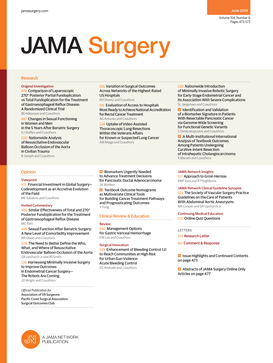Open Anterior Mesh Repair vs Modified Open Anterior Mesh Repair for Groin Hernia in Women: A Randomized Clinical Trial.
IF 15.7
1区 医学
Q1 SURGERY
引用次数: 0
Abstract
Importance Most women in low- and middle-income countries lack access to laparoscopic methods for groin hernia repair; therefore, an open technique through which both inguinal and femoral hernias can be treated is needed. This could be an option in the absence or inability to use laparoscopic methods. Objective To determine the safety and effectiveness of open anterior mesh (OAM) repair compared with modified open anterior mesh (MOAM) repair, which includes opening the transversalis fascia and covering the femoral canal with a mesh flap. Design, Setting, and Participants This was a parallel, 2-arm, double-blind, randomized clinical trial conducted in Northern Uganda, in East Africa, at 2 public hospitals between October 2019 and February 2023. Included in the study were adult women 18 years and older with a primary groin hernia, American Society of Anesthesiologists (ASA) class I or II, and the ability to give informed consent. Interventions OAM in the control arm and MOAM in the intervention arm. Main Outcomes and Measures The primary outcome was groin hernia recurrence 1 year postoperatively. Results A total of 200 participants (mean [SD] age, 52.7 [14.0] years) were included in the study; 99 (49.5%) were allocated to OAM repair, and 101 (50.5%) were allocated to MOAM repair. Nearly 45% of the participants (89 of 200) had a femoral hernia; therefore, 35 of 99 participants (35.4%) in the control arm received the intervention procedure. One year postoperatively, the overall recurrence was 5.6% (11 of 195 participants), and the intention-to-treat analysis showed that 4 of 97 participants (4.1%) in the control arm and 7 of 98 participants (7.1%) in the intervention arm had recurrence (absolute difference = -3.0 percentage points; 95% CI, -9.5 to 3.4; P = .36). Conclusions and Relevance Results of this randomized clinical trial demonstrate that the MOAM repair was a good option for groin hernia repair in women in low-resource settings. Femoral hernias were very common in the study population, and exposure of the femoral canal was essential to detect these hernias. Trial Registration ISRCTN Identifier: ISRCTN10330683.开放式前路补片修复与改良开放式前路补片修复治疗女性腹股沟疝:一项随机临床试验。
低收入和中等收入国家的大多数妇女无法获得腹腔镜腹股沟疝修补术;因此,需要一种开放的技术,通过它可以治疗腹股沟疝和股疝。这可能是在没有或无法使用腹腔镜方法的情况下的一种选择。目的比较开放式前路补片(OAM)与改良式开放式前路补片(MOAM)的安全性和有效性。改良式开放式前路补片包括打开股横筋膜,用补片瓣覆盖股管。设计、环境和参与者这是一项平行、双盲、随机临床试验,于2019年10月至2023年2月在东非乌干达北部的两家公立医院进行。研究对象包括18岁及以上患有原发性腹股沟疝的成年女性,美国麻醉医师协会(ASA)分级为I或II级,并有能力给予知情同意。干预臂的soam和干预臂的MOAM。主要观察指标:术后1年腹股沟疝复发。结果共纳入200例受试者,平均[SD]年龄52.7[14.0]岁;OAM修复99例(49.5%),MOAM修复101例(50.5%)。近45%的参与者(200人中有89人)患有股疝;因此,对照组99名参与者中有35名(35.4%)接受了干预程序。术后1年,总体复发率为5.6%(195例患者中有11例),意向治疗分析显示,对照组97例患者中有4例(4.1%)复发,干预组98例患者中有7例(7.1%)复发(绝对差异= -3.0个百分点;95% CI, -9.5 ~ 3.4;p = .36)。结论和相关性这项随机临床试验的结果表明,MOAM修复术是低资源环境下女性腹股沟疝修复术的一个很好的选择。股疝在研究人群中非常常见,暴露股管对于检测这些疝是必不可少的。试验注册号:ISRCTN10330683。
本文章由计算机程序翻译,如有差异,请以英文原文为准。
求助全文
约1分钟内获得全文
求助全文
来源期刊

JAMA surgery
SURGERY-
CiteScore
20.80
自引率
3.60%
发文量
400
期刊介绍:
JAMA Surgery, an international peer-reviewed journal established in 1920, is the official publication of the Association of VA Surgeons, the Pacific Coast Surgical Association, and the Surgical Outcomes Club.It is a proud member of the JAMA Network, a consortium of peer-reviewed general medical and specialty publications.
 求助内容:
求助内容: 应助结果提醒方式:
应助结果提醒方式:


